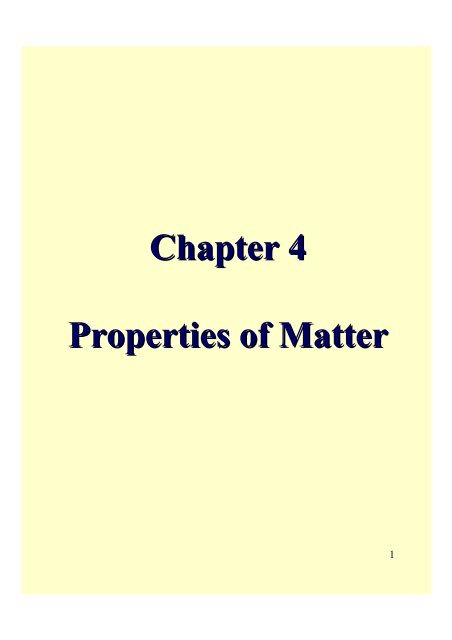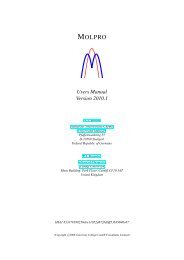Chapter 4 Properties of Matter
Chapter 4 Properties of Matter
Chapter 4 Properties of Matter
Create successful ePaper yourself
Turn your PDF publications into a flip-book with our unique Google optimized e-Paper software.
<strong>Chapter</strong> 4<br />
<strong>Properties</strong> <strong>of</strong> <strong>Matter</strong><br />
1
4.1 <strong>Properties</strong> <strong>of</strong> substances<br />
properties – characteristic <strong>of</strong> the substance and<br />
give it a unique identity<br />
physical properties – inherent characteristics <strong>of</strong><br />
a substance<br />
chemical properties – the ability <strong>of</strong> a substance<br />
to form new substance either by reaction<br />
or by decomposition<br />
ex. chlorine Cl 2<br />
• not burn but will support the combustion<br />
<strong>of</strong> other substances<br />
• used as bleaching agent<br />
• combine with Na to form salt<br />
2
4.2 Physical changes<br />
changes in physical properties or changes in the<br />
state <strong>of</strong> matter without changing in composition<br />
ex. ice melting<br />
water boiling<br />
Pt wire is heated in a burner flame, color<br />
changes from silvery metallic to glowing<br />
red<br />
3
4.3 Chemical changes<br />
new substances are formed that have different<br />
properties and composition from the original<br />
material<br />
ex. 1.000 g copper + 0.251 g oxygen<br />
1.251 g copper(II) oxide<br />
ex. water can be decomposed chemically into<br />
hydrogen and oxygen<br />
4
chemical equation – a shorthand method for<br />
expressing chemical changes<br />
electrical<br />
2 H 2 O 2 H 2 + O 2<br />
energy<br />
Δ<br />
2 Cu + O 2 2 CuO<br />
reactant product<br />
5
4.4 Conservation <strong>of</strong> mass<br />
law <strong>of</strong> conservation <strong>of</strong> mass – no change is<br />
observed in the total mass <strong>of</strong> the substances<br />
involved in a chemical reaction<br />
mass <strong>of</strong> reactants = mass <strong>of</strong> products<br />
ex. water hydrogen + oxygen<br />
100.0 g 11.2 g 88.8 g<br />
100.0 g<br />
7
4.5 Energy<br />
energy is the capacity <strong>of</strong> matter to do work<br />
exists in many form: mechanical, chemical,<br />
electrical, heat, nuclear, radiant or light energy<br />
matter can have both potential and kinetic energy<br />
potential energy (PE) – stored energy<br />
kinetic energy (KE) – energy that matter<br />
possesses due to its motion<br />
energy can be converted from one form to another<br />
mechanical energy<br />
electric generator<br />
> 90% efficiency<br />
electrical energy<br />
solar energy<br />
~ 15% efficiency<br />
electrical energy<br />
in chemistry, energy is most frequently expressed<br />
as heat<br />
8
4.6 Heat: quantitative measurement<br />
SI unit <strong>of</strong> energy: joule (J)<br />
4.184 J = 1 cal (calorie)<br />
1 calorie – the quantity <strong>of</strong> heat energy required to<br />
change the temperature <strong>of</strong> 1 g <strong>of</strong> water by<br />
1 o C (from 14.5 o C to 15.5 o C)<br />
kilocalorie (kcal) kilojoule (kJ)<br />
heat capacity – the quantity <strong>of</strong> heat required to<br />
change the temperature <strong>of</strong> 1 g <strong>of</strong> the<br />
substance by 1 o C<br />
mass <strong>of</strong> specific heat<br />
Δt= heat<br />
substance <strong>of</strong> substance<br />
raise the temperature <strong>of</strong> 200 g <strong>of</strong> water by 10 o C,<br />
the amount <strong>of</strong> heat needed<br />
(200 g)(4.184 J/g o C)(10 o C) = 8.37 × 10 3 J9
ex. 4.1 If 1638 J raise the temperature <strong>of</strong> 125 g<br />
<strong>of</strong> the solid from 25.0 o C to 52.6 o C,<br />
calculate the specific heat in J/g o C.<br />
heat 1638 J<br />
specific heat = ──── = ─────────<br />
g × Δt (125 g)(52.6 – 25) o C<br />
= 0.475 J/g o C<br />
ex. 4.2 a metal with a mass <strong>of</strong> 212 g is heated<br />
to 125.0 o C, and then dropped into 375 g<br />
water at 24 o C. the final temperature <strong>of</strong><br />
water is 34.2 o C. specific heat <strong>of</strong> metal<br />
heat gain by water = (375 g)(10.2 o C)(4.184J/g o C)<br />
= 1.60 × 10 4 J<br />
heat<br />
1.60 × 10 4 J<br />
specific heat = ──── = ─────────<br />
<strong>of</strong> metal g × Δt (212 g)(125 – 34.2) o C<br />
= 0.831 J/g o C<br />
10
4.7 Energy in chemical changes<br />
in chemical changes, matter either absorbs or<br />
releases energy<br />
• electric energy produced in lead storage battery<br />
• light energy in light stick<br />
• heat and light are released from combustion <strong>of</strong><br />
fuels<br />
• electrical energy is used in electroplating <strong>of</strong><br />
metal<br />
• radiant energy is used by green plants in<br />
photosynthesis<br />
11
4.8 Conservation <strong>of</strong> energy<br />
• electrolysis <strong>of</strong> water<br />
electrical energy is absorbed<br />
products have higher potential energy<br />
• hydrogen is burned in O 2<br />
energy is released<br />
product has lower potential energy<br />
Law <strong>of</strong> conservation <strong>of</strong> energy –<br />
energy can be neither created nor destroyed,<br />
though it can be transformed from one to another<br />
12












![Hetero [6+3] Cycloaddition of Fulvenes with N-Alkylidene Glycine ...](https://img.yumpu.com/35423358/1/190x245/hetero-6-3-cycloaddition-of-fulvenes-with-n-alkylidene-glycine-.jpg?quality=85)



